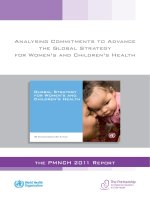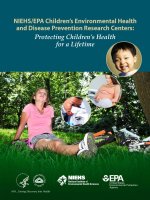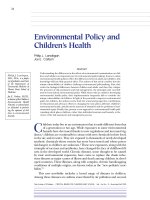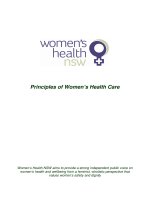SPECIAL REPORT: National Survey of Children’s Health Finds Intact Family and Religious Participation Are Associated with Fewer Developmental Problems in School-Age Children pdf
Bạn đang xem bản rút gọn của tài liệu. Xem và tải ngay bản đầy đủ của tài liệu tại đây (1.29 MB, 36 trang )
Marriage, Religion, and the Common Good
SPECIAL REPORT:
National Survey of Children’s Health
Finds
Intact Family and Religious Participation
Are Associated with
Fewer Developmental Problems in School-Age
Children
By
Nicholas Zill, Ph.D. and Philip Fletcher, Ph.D.
December 16
th
, 2008
National Survey of Children’s Health Finds Intact
Family and Religious Participation Are Associated
with Fewer Developmental Problems in School-
Age Children
By
Nicholas Zill, Ph.D. and Philip Fletcher, Ph.D.
1
New analyses of data from a large-scale federal survey of child health and
development show that children and adolescents are less likely to exhibit
problems in school or at home if they live with both their biological parents and
attend religious services regularly. For example, young people not living with both
parents and not attending services regularly are five times more likely to have
repeated a grade in school than those living with both parents and attending
religious services weekly or monthly. Thirty-four percent of the former group had
repeated a grade, compared with six percent of the latter. And 53 percent of the
former group – versus 21 percent of the latter – had their parents contacted by the
school because of conduct or achievement problems the youth was having at
school. These differences hold up after controlling for family income and poverty,
low parent education levels, and race and ethnicity.
An intact two-parent family and regular church attendance are each
associated with fewer problem behaviors, more positive social development, and
fewer parental concerns about the child’s learning and achievement. Taken
together, the two home-environment factors have an additive relationship with
child well-being. That is, children who live in an intact family and attend religious
services regularly generally come out best on child development measures, while
children who do neither come out worst. Children with one factor in their favor,
but not the other, fall in between, scoring less well than those who have both
factors going for them, but better than those who have neither factor in their favor.
Grade repetition, school contacts, and parental concern about child
achievement are more strongly linked to a lack of an intact two-parent family than
to a lack of religious participation. For problem behavior and social development,
1
Biographies: see pp. 35-36.
the strength of the association with religious attendance is about equal to that with
family integrity. An intact two-parent family and regular religious participation are
also associated with the parent reporting less parenting stress and a better parent-
child relationship. These family functioning differences may help to explain the
parallel differences in children’s well-being.
Much social science research on child development has focused on the role
played by social class and socioeconomic factors like childhood poverty and
family income, low parent education, and the more limited opportunities and
negative influences faced by minority children. And indeed, the survey data show
that the developmental problems listed above are more common among children
from low-income families, families where parents have less than a high school
education, and Black and Hispanic families. Some social scientists even contend
that family structure and religious participation are only linked to developmental
outcomes because of their association with socioeconomic disparities. (See reviews
by Glenn & Sylvester, 2008; Bridges & Moore, 2002). However, when these
socioeconomic factors are taken into account through multiple regression analysis
of the survey data, the lack of an intact two-parent family and of regular religious
training continue to be linked with developmental problems among children and
adolescents. The strength of the statistically-adjusted regression coefficients is
somewhat reduced compared to that of the uncontrolled correlation coefficients,
but family structure and religious participation remain statistically significant
explanatory factors. And their associations with children’s developmental
difficulties are comparable in magnitude to the associations with family income
and poverty, low parent education, and minority-group membership.
How many U.S. children live with both parents and get regular
religious training? Despite the developmental advantages associated with an
intact two-parent family and religious training, the survey shows that nowadays
less than half of all American children between 6 and 17 years of age – 45 percent
– live with both biological parents and attend religious services weekly or
monthly. Another 30 percent attend religious services regularly but live with one
parent only, with one parent and a stepparent, or with foster parents or other
relatives. Still another 13 percent live with both parents but attend religious
services infrequently or not at all. And 12 percent are not living with both parents
AND not attending church, synagogue, or mosque regularly.
The overall proportion of young people aged 6-17 living with both biological
parents is 58 percent.
2
The overall proportion reported to attend religious services
weekly or monthly is 75 percent.
3
Across the 50 states of the U.S., there is considerable state-to-state variation
in the proportion of children living with both biological parents. In Southern states
with large black populations, such as Mississippi, Arkansas, Alabama, and
Louisiana, less than half of all children live with both parents. (Nowadays, 70
percent of black children nationwide are born outside of marriage, as are 25
percent of white children and 48 percent of Hispanic children.) On the other hand,
in Midwestern and Western states like North Dakota, Utah, Iowa, and Minnesota,
upwards of two-thirds of all children reside with both parents. The proportion of
young people in intact families is also relatively high in the predominantly
suburban state of New Jersey and in the New England states.
The proportion of children reported to attend religious services weekly or
monthly shows a different pattern of variation across states. The proportion is
highest – upwards of 85 percent – in Southern states like Mississippi, Louisiana,
Alabama, and South Carolina. The proportion is lowest in the New England states
of Vermont, New Hampshire and Maine, with less than or just over half of young
people attending services regularly. North Central states like the Dakotas and
Nebraska, Iowa and Minnesota, come out relatively high in both family stability
and religious observance. So does Utah, with its predominantly Mormon
population.
Source of the Data. Data analyzed in the study came from public-use
microdata files of the National Survey of Children’s Health (NSCH), conducted by
the National Center for Health Statistics (NCHS) in 2003. The data were collected
through telephone interviews with parents of 102,353 children and teens in all 50
states and the District of Columbia. 68,996 of the young people were in the age
2
This proportion is lower than that put out by the U.S. Census Bureau (2005) because Census counts children living with a
biological parent and a stepparent as residing with “both parents.”
3
This proportion may be overstated, as survey methodological research has found a social desirability bias in people’s
reports of their church attendance. When respondents answer questions about frequency of attendance at religious
services via a computer-assisted self-administered interview (CASI) they report less frequent attendance than when
questioned by a human interviewer.
range 6 through 17 years, the age group that was the focus of the study. The
survey sample in this age range represented a population of nearly 49 million
young people nationwide. Further information about the NSCH is available in
NCHS publications (Blumberg et al, 2005; Bramlett & Blumberg, 2007).
Analysis Methods. We constructed the two major independent variables
from recoded background variables available in the NSCH public use file.
The Parents In Household variable was based on parent responses to
questions regarding the exact relationship of adults in the household to the subject
child.
Families were classified as having in the household: 1) both biological
parents of the child, or two adopted parents; 2) a biological parent and a
stepparent; 3) the biological mother only; or 4) other parent figures, including the
biological father only, grandparent(s) or other relatives, or foster parent(s), who
could be biologically related or unrelated to the child.
4
(The NSCH questionnaire
did not inquire as to the current marital status of the parent figures in the
household.)
The Religious Participation variable was based on parent responses to the
question, “About how often does [CHILD] attend a religious service?” Responses
to this question were classified into the following categories: 1) Once a week or
more often (>Weekly); 2) Less than once a week, but at least once a month
(>Monthly); 3) Less than once a month but at least once or twice a year
(<Monthly); or 4) Less than once or twice a year or not at all (Never).
4
In the combined religious attendance and family structure charts, “INTACT FAMILY” is the first class, and “NON-INTACT
FAMILY” is the last three classes.
Percent of Children Repeating a Grade by Frequency of
Religious Attendance: U.S. Children Aged 6-17, 2003
10.2
8.7
20.7
20.6
0
5
10
15
20
25
30
>Weekly >Monthly <Monthly Never
Frequency of Religious Attendance
Percent of Children Who Repeated a Grade
Source: National Survey of Children’s Health (NSCH)
This chart illustrates the correlation between frequency of religious attendance and
grade repetition.
Children who attended religious services at least monthly have a much lesser
chance of repeating a grade than those who attended religious services
weekly or not at all.
Percent of Children Repeating a Grade by Family Structure:
U.S. Children Aged 6 -17, 2003
6.5
21.8
19.9
21.9
0
5
10
15
20
25
Both biological
parents or two
adoptive parents
One biological
parent, one
stepparent
Mother only Other
Percent of Children Who Repeated a Grade
Source: National Survey of Children’s Health (NSCH)
Family Structure
This chart shows the relationship between family structure and grade
repetition.
Children living with both biological parents or two adoptive parents have a
much lesser chance of repeating a grade than those in any other family
structure.
<MONTHLY/
NEVER
>WEEKLY/
MONTHLY
INTACT FAMILY
NON -INTACT FAMILY
34
15
8
6
0
5
10
15
20
25
30
35
Percent of Children Repeating a Grade by Religious Attendance and Family
Structure: U.S. Children Aged 6-17, 2003
Religious Attendance and Family Structure Combined
Percent of Children
Who Repeated a Grade
Source: National Survey of Children's Health (NSCH)
This chart illustrates the correlation between religious attendance, family
structure and grade repetition.
Children from intact families who worship frequently are least likely to repeat
a grade. Note the dramatic difference between intact and non-intact families.
Percent of Children Whose Parents Were Contacted by School about
Children's Problems by Frequency of Religious Attendance:
U.S. Children Aged 6 -17, 2003
24.6
31.4
31.9
41.7
0
5
10
15
20
25
30
35
40
45
>Weekly >Monthly <Monthly Never
Frequency of Religious Attendance
Percent of Children In Group
Source: National Survey of Children’s Health (NSCH)
This chart shows the relationship between frequency of religious attendance
and parents contacted about children’s problems in school.
Children who worship at least weekly are least likely to have their parents
contacted by school teachers or administrators about school-related
problems.
21.7
37.7
39.4
38.2
0
5
10
15
20
25
30
35
40
45
Both biological
parents or two
adoptive parents
One biological
parent, one
stepparent
Mother only Other
Percent of Children In Group
Family Structure
Source: National Survey of Children’s Health (NSCH)
Percent of Children Whose Parents Were Contacted by School about
Children’s Problems by Family Structure: U.S. Children Aged 6-17, 2003
This chart illustrates the correlation between family structure and parents
contacted about children’s problems in school.
Children who live with both biological parents or two adoptive parents are
least likely to have their parents contacted by school teachers or
administrators about school-related problems.
<MONTHLY/
NEVER
>WEEKLY/
MONTHLY
INTACT FAMILY
NON -INTACT FAMILY
53
33
25
21
0
10
20
30
40
50
60
Percent of Children Whose Parents Were Contacted by School about Children's
Problems by Religious Attendance and Family Structure: U.S. Children Aged 6-17, 2003
Religious Attendance and Family Structure Combined
Percent of Children in Group
Source: National Survey of Children's Health (NSCH)
This chart shows the relationship between religious attendance, family
structure, and parents contacted about children’s problems in school.
Children from intact families who worship frequently are least likely to have
their parents contacted by school teachers or administrators about school-
related problems.
Child Behavior Problems by Frequency of Religious Attendance:
U.S. Children Aged 6 -17, 2003
49.2
50.4
51.1
51.8
45.0
46.0
47.0
48.0
49.0
50.0
51.0
52.0
53.0
54.0
55.0
>Weekly >Monthly <Monthly Never
Frequency of Religious Attendance
Mean Behavior Problems Score
Source: National Survey of Children’s Health (NSCH)
This chart illustrates the correlation between frequency of religious
attendance and child behavior problems.
Children who worship at least weekly exhibit the fewest behavior problems.
Child Behavior Problems by Family Structure:
U.S. Children Aged 6-17 years, 2003
49.0
51.8
51.5
50.4
45.0
46.0
47.0
48.0
49.0
50.0
51.0
52.0
53.0
54.0
55.0
Both biological parents
or two adoptive parents
One biological parent,
one stepparent
Mother only Other
Family Structure
Mean Behavior Problems Score
Source: National Survey of Children’s Health (NSCH)
This chart shows the relationship between family structure and child behavior
problems.
Children who live with both biological parents or two adoptive parents exhibit
the fewest behavior problems.
<
MONTHLY/
NEVER
>WEEKLY/
MONTHLY
INTACT FAMILY
NON -INTACT FAMILY
52.8
50.9
50.5
48.5
46
47
48
49
50
51
52
53
Child Behavior Problems by Religious Attendance and Family Structure
U.S. Children Aged 6 -17, 2003
Mean Behavior Problems Score
Religious Attendance and Family Structure Combined
Source: National Survey of Children's Health (NSCH)
This chart illustrates the correlation between religious attendance, family
structure, and child behavior problems.
Children from intact families who worship frequently exhibit the fewest
behavior problems.
Children's Positive Social Development by Frequency of Religious Attendance
U.S. Children Aged 6-17, 2003
50.7
49.6
49.7
48.4
45.0
46.0
47.0
48.0
49.0
50.0
51.0
52.0
53.0
>Weekly >Monthly <Monthly Never
Frequency of Religious Attendance
Mean Social Development Score
Source: National Survey of Children’s Health (NSCH)
This chart shows the relationship between frequency of religious attendance
and children’s positive social development.
According to parent reports, children who worship at least weekly are more
likely to exhibit positive social behavior, including showing respect for
teachers and neighbors, getting along with other children, understanding
other people’s feelings, and trying to resolve conflicts with classmates, family,
or friends.
Children's Positive Social Development by Family Structure:
U.S. Children Aged 6 -17, 2003
50.8
48.5
49.0
48.2
45.0
46.0
47.0
48.0
49.0
50.0
51.0
52.0
53.0
54.0
55.0
Both biological parents
or two adoptive parents
One biological parent,
one stepparent
Mother only Other
Family Structure
Mean Social Development Score
Source: National Survey of Children’s Health (NSCH)
This chart illustrates the correlation between family structure and children’s
positive social development.
According to parent reports, children who live with both biological parents or
two adoptive parents are more likely to exhibit positive social behavior,
including showing respect for teachers and neighbors, getting along with
other children, understanding other people’s feelings, and trying to resolve
conflicts with classmates, family, or friends.
<MONTHLY/
NEVER
>WEEKLY/
MONTHLY
INTACT FAMILY
NON -INTACT FAMILY
47.6
49.3
49.6
51.2
45
46
47
48
49
50
51
52
Children’s Positive Social Development by Religious Attendance and
Family Structure: U.S. Children Aged 6-17, 2003
Mean Social Development Score
Source: National Survey of Children's Health (NSCH)
Religious Attendance and Family Structure Combined
This chart shows the relationship between religious attendance, family
structure, and children’s positive social development.
According to parent reports, children from intact families who worship
frequently are more likely to exhibit positive social behavior, including
showing respect for teachers and neighbors, getting along with other children,
understanding other people’s feelings, and trying to resolve conflicts with
classmates, family, or friends.
Parental Concerns about Children's Achievement by
Frequency of Religious Attendance: U.S. Children Aged 6-17, 2003
50.1
50.2
49.4
49.9
48.8
49.0
49.2
49.4
49.6
49.8
50.0
50.2
50.4
50.6
50.8
51.0
>Weekly >Monthly <Monthly Never
Frequency of Religious Attendance
Mean Parental Concerns Score
Source: National Survey of Children’s Health (NSCH)
This chart illustrates the correlation between frequency of children’s religious
attendance and parental concerns about children’s achievement.
Children who worship at least monthly are slightly more likely to have parents
concerned about their children’s achievement than children who worship less
frequently.
Parental Concerns about Children's Achievement by Family Structure:
U.S. Children Aged 6-17, 2003
48.8
50.7
51.8
52.5
45.0
46.0
47.0
48.0
49.0
50.0
51.0
52.0
53.0
54.0
55.0
Both biological parents
or two adoptive parents
One biological parent,
one stepparent
Mother only Other
Family Structure
Mean Parental Concerns Score
Source: National Survey of Children’s Health (NSCH)
This chart shows the relationship between family structure and parental
concerns about children’s achievement.
Children who live with both biological parents or two adoptive parents are
least likely to have parents who are concerned about their children’s
achievement.
<MONTHLY/
NEVER
>WEEKLY/
MONTHLY
INTACT FAMILY
NON -INTACT FAMILY
50.7
51.9
48.9
48.8
47.0
47.5
48.0
48.5
49.0
50.0
50.5
51.0
51.5
52.0
Parental Concerns about Children’s Achievement by Religious Attendance and
Family Structure: U.S. Children Aged 6-17, 2003
Mean Parental Concerns Score
Religious Attendance and Family Structure Combined
Source: National Survey of Children's Health (NSCH)
49.5
This chart examines the correlation between religious attendance, family
structure, and parental concerns about children’s achievement.
Children from intact families who worship frequently are least likely to have
parents concerned about their children’s achievement.
Parenting Stress by Frequency of Religious Attendance:
U.S. Children Aged 6-17, 2003
49.8
50.5
50.8
50.0
48.8
49.0
49.2
49.4
49.6
49.8
50.0
50.2
50.4
50.6
50.8
51.0
>Weekly >Monthly <Monthly Never
Frequency of Religious Attendance
Mean Parenting Stress Score
Source: National Survey of Children’s Health (NSCH)
This chart shows the relationship between frequency of children’s religious
attendance and parenting stress.
Parents of children who worship at least weekly have the lowest parenting
stress levels.
Parenting Stress by Family Structure:
U.S. Children Aged 6-17, 2003
48.9
52.0
52.1
50.6
45.0
46.0
47.0
48.0
49.0
50.0
51.0
52.0
53.0
54.0
55.0
Both biological parents
or two adoptive parents
One biological parent,
one stepparent
Mother only Other
Family Structure
Mean Parenting Stress Score
Source: National Survey of Children’s Health (NSCH)
This chart examines the correlation between children’s family structure and
parenting stress.
Children living with both biological parents or two adoptive parents have
parents with the lowest parenting stress levels.
<MONTHLY/
NEVER
>WEEKLY/
MONTHLY
INTACT FAMILY
NON -INTACT FAMILY
51.9
51.2
49.9
48.7
47.0
47.5
48.0
48.5
49.0
49.5
50.0
50.5
51.0
51.5
52.0
Parenting Stress by Children's Religious Attendance and Family Structure
U.S. Children Aged 6-17, 2003
Children ’s Religious Attendance and Family Structure Combined
Source: National Survey of Children's Health (NSCH)
Mean Parenting Stress Score
This chart shows the relationship between religious attendance, family
structure, and parenting stress.
Children from intact families who worship frequently have parents with the
lowest parenting stress levels.
Quality of Parent -Child Relationship by Frequency of Religious Attendance:
U.S. Children Aged 6-17, 2003
50.7
49.5
49.8
48.4
47.5
48.0
48.5
49.0
49.5
50.0
50.5
51.0
>Weekly >Monthly <Monthly Never
Frequency of Religious Attendance
Mean Positive Relationship Score
Source: National Survey of Children’s Health (NSCH)
This chart examines the correlation between children’s frequency of religious
attendance and the quality of the relationship with their parents.
Children who worship at least weekly are more likely to have a high-quality
relationship with their parents.
Quality of Parent -Child Relationship by Family Structure:
U.S. Children Aged 6-17, 2003
50.7
48.0
49.7
47.9
45.0
46.0
47.0
48.0
49.0
50.0
51.0
52.0
53.0
54.0
55.0
Both biological parents
or two adoptive parents
One biological parent,
one stepparent
Mother only Other
Family Structure
Mean Positive Relationship Score
Source: National Survey of Children’s Health (NSCH)
This chart shows the relationship between children’s family structure and the
quality of the relationship with their parents.
Children who live with both biological parents or two adoptive parents are
most likely to have a high-quality relationship with their parents.









